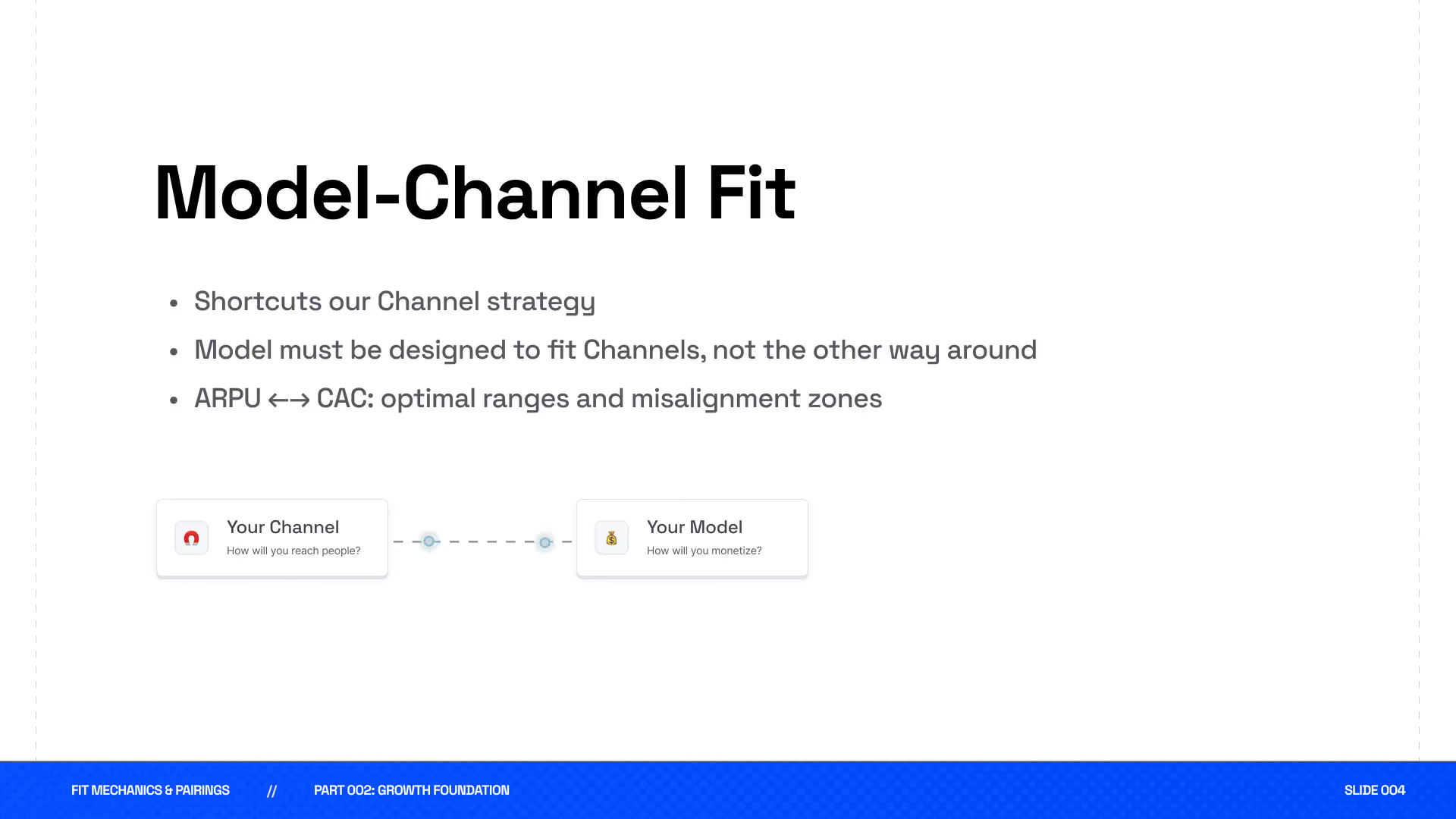
Conversation

🥳 Feedback Received!
Thanks for taking a moment to share your thoughts — it genuinely helps us make each chapter sharper.
What happens next:
- Your feedback goes straight to our product team.
- We’ll use it to refine lessons, clarify examples, and make the program even more useful.
Appreciate you helping make this program better for everyone.
Ready for your next challenge? 👇
Model-channel fit
Now we arrive at one of the most relevant and practical pairings for your purposes in the Growth Program: Model-Channel Fit.

Most of you are here to figure out how to predictably and scalably acquire customers. I.e. locking in the Channel portion of your Foundational Five.
Model-Channel Fit plays a huge role in helping you do just that.
1. The Ultimate Channel Filter
The value of this fit is simple and important: it provides a powerful filter that instantly eliminates entire categories of acquisition channels.
Your model determines your ARPU, while channels have inherent cost bands baked into them. Since we do not own or control our channels, we must design our model to be aligned with the default channel costs.
Here's how the four major acquisition motions typically break down by CAC bands:
- Virality (Lowest CAC): Includes pull virality, push virality, incentivized virality, and word-of-mouth. Generally requires free or very low-value Models to maximize the flywheel potential.
- Content (Low-Medium CAC): Ranges from low-CAC strategies like UGC SEO to higher-CAC content marketing. Content has a wide range of “model tolerance.” It can support high-value Models since it is a high-context channel that can educate users of (typically) more complicated products. And it can also support low-value Models as certain Content methods have the potential for very low CAC.
- Paid Media (Medium CAC): Direct paid acquisition through social, search, and display advertising. Has a tighter optimal range than Content. Paid requires sufficient ARPU to support advertising costs while maintaining healthy unit economics. But not so high a price point that it creates too much friction in the customer consideration process. E.g. when’s the last time you snap-bought something that cost $1,000 after seeing a single ad?
- Sales (Highest CAC): Sales-assisted models through full enterprise sales motions. Requires high ARPU to support the cost of sales teams and longer sales cycles.
Key Notes
Every growth engine combines an acquisition motion with a monetization motion (self-serve, hybrid, or sales-led), creating different CAC profiles.
And there are multiple misalignment zones across the ARPU (Model) → CAC (Channel) spectrum where businesses frequently struggle because their ARPU (and Product) doesn't align well with any Channel.
We'll explore these misalignment zones (and how to avoid them!) in the next part of the program when we dive deep into motion pairings and channel selection.
But a key point is that it’s not enough to have an ARPU > Channel CAC.
This provides the first filter layer: all things aside, can we even afford this Channel?
Product-Channel fit (next lesson) provides the next key filter.
Of all the Channels we can afford, which ones are still viable after considering how our Product aligns with the inherent rules and “DNA” built into each Channel?
For now, let's continue with the basics for assessing Model-Channel fit.
2. Assessing the Fit: How to Know You Have It
Assessing Model-Channel fit involves monitoring your channel performance against your model's constraints in real-world conditions.
ARPU > CAC: Are you able to acquire customers through your chosen channels at or below your target CAC? This needs constant monitoring as channel costs fluctuate with competition and market conditions.
Scalability Test: Can you continue to acquire customers through your channels at an acceptable CAC as you increase spend? Many channels appear to work at a small scale but break down as you try to grow, revealing misalignment between your model and the channel's ceiling.
Payback Period: Are customers acquired from specific channels paying back their acquisition cost within your target timeframe? Different channels often produce customers with different value and payback velocities.
Alright, now onto the second layering filter we use to hone in on our optimal Channel: Product-Channel Fit.


